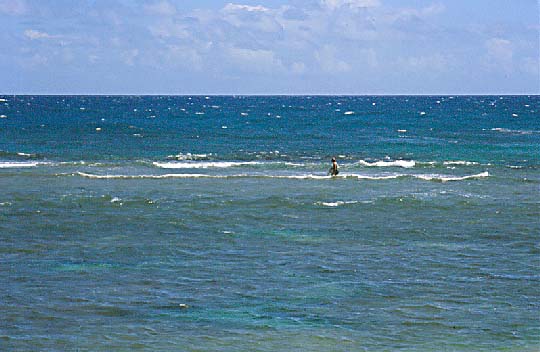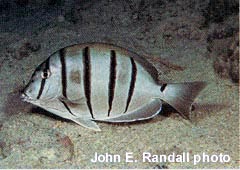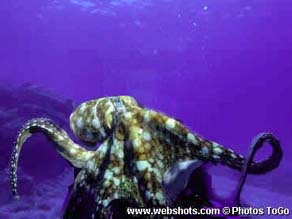 |
 |
 |
|||||
|
|
|
|
|
|
|
|
|
|
|
|||||||
A throw-net fisherman on the reef off Ha‘ena State Park
|
|||||||
|
Reef fishing yielded certain small fish and octopus at Ha‘ena. While the methods for fishing have changed a little since traditional times, much remains the same. This comes out in stories related by Samson Mahuiki about his mother fishing on the reef at Ha‘ena: "She was very knowledgeable about how to obtain food supply from the reef; she was cracker jack with the loli, with the uana, the pukas, how to use them. This is the secret: the generation before, and the people that grew up with them, tell us, certain areas are safe for you. From here, from the shoreline to so many feet out, it's safe, no more eel. And it's been proven all where these guys live." Knowing where to avoid the eels was important to fishing on the reef, since it often involved reaching into pukas (holes) in the reef where both fish and eels like to hide. Because she knew where it was safe, his mother could fish even in the rough seas of the winter months. One of her specialties was catching manini:
|
||
|
|
||
|
Manini
|
"Manini, she'd get them where the surf was strong, because all that kind of small fish got to hide, they got to stay in their house, stay underneath the rock. She always went in with a flour bag, just get two, one for plug the back door, and the rest, she just grab the fish and put them in the bag. But you got to do that when the surf is strong: the fish are going to stay in. They're not going to look for place to run away, for the current is too strong for them to stay out. They got to hide. But I look at that, the surf is even too strong for me! My mother, she used to go right in the surf and pick them up. That was her skill, She was crazy for do a thing like that, but that was her skill."
|
|
|
|
|
The other skill she had on the reef was fishing for octopus, or he‘e. Samuel Kamakau explains that
|
||
|
|
||
|
Fishing for octopus is a fine art, especially in recent times. For, Kamakau noted even back in the 19th century, "the number of he'e caught today are only fifty percent of those caught in the old days." There were many methods of octopus fishing back then, including fishing with lures and spearing them from canoes. That was easier when they were more plentiful. But the art of catching them on the reef, as is practiced today, requires a good eye. Kamakau writes,
|
||
|
|
||
|
"See, plenty guys wanted to beat her" Samson explains in modern terms. "But if you're not too good, the best thing you're going to do for anybody, if you cannot see well, is go walk in front, go walk all over, because if the squid never move, and if you had spooked them, and you cannot see them, you're not going to pick them up. But because you don't spook them, any movement they made, because it covered himself with either pearl or sand, any movement they make is going to get somebody's attention, eh? "One time this old guy came and picked everything up, because they know what they're looking for. You don't have to see the squid, you look for telltale signs. So that's the trouble with one guy who cannot tell telltale signs--jam them up. You're setting them up for the squid-man--the next guy! So if you only can see, then you're gone."
|
He‘e: the Hawaiian Octopus
|
|
|
|
|
"Got so bad that she'd go down there and--broken stick, you know, if you like to tease the squid for come out? She didn't take nothing, spear like that, like eveybody does, because somebody else would see, "eh, must be good time, because she's going, eh?" I mean, the good guys, they're not going unless it's guaranteed, or ideal conditions. So this way you got to know how to read the signs, or follow the other guy! So she never did take anything when she went down to the beach, so nobody'd know where she's going. And that's the trouble about fishing, eh? If you're watching the other guy, you jam him up. You got to go make the rounds so you know, not after the guy who catches everything."
|
||
|
|
||
|
More about reef fishing at Ha‘ena is told by Frederich Wichman in his book "Kauai: Ancient Place-Names And Their Stories": "Kaua‘i's only lagoon, Kai-kua‘au-o-Ha‘ena, 'lagoon sea of Ha‘na,' protects Makua Bay. Papa-loa, "long reef," encloses the lagoon. A fishing hole near shore is named Ka-‘aulama-poko, "light from a short-burning torch," because it can be fished at night using a kukui nut torch, which never burned for very long. Ka-lua-‘aweoweo, "‘aweoweo hole," is the fishing hole at the farthest point from land. The ‘aweoweo (bigeye fish) gather in this grotto. It is a twenty-inch-long fish having white flesh. It was eaten raw, cooked, or dried. A large school of young ‘aweoweo, called ‘alalauä, swimming into a bay was an omen of the death of a high chief. Here are two Hawaiian proverbs regarding the ‘alalaua:
|
||
|
|
||
|
Fishing on and beyond the reef was an essential part of life at Ha‘ena. More about fishing is discussed in the next page.
|
||
|
|
||
| |
| |
|
|
 |
| Ha'ena Home | Map Library | Site Map | Hawaiian Islands Home | Pacific Worlds Home |

|
|||
| Copyright 2001 Pacific Worlds & Associates • Usage Policy • Webmaster |
|||






